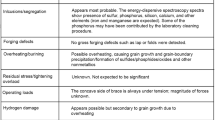Abstract
This paper presents an approach which scales up current model-based diagnosis techniques to large, unstructured systems. It is based on the fact that it is sufficient to consider only a small part of a system in order to determine those components which cause its malfunction. By identifying minimal substructures of the system whose diagnoses are independent of the rest we reduce the number of diagnoses to be investigated and restrict behavior prediction to that part of the system's structure which is necessary to discriminate among competing diagnoses. Hence, our approach has the potential to save computational costs significantly and therefore extends the applicability of model-based techniques.
Similar content being viewed by others
References
A. Beschta, O. Dressler, H. Freitag, M. Montag and P. Struss, A model-based approach to fault localization in power transmission networks, Intelligent Syst. Eng. (1992).
R. Davis, Diagnostic reasoning based on structure and behaviour, Artificial Intelligence 24 (1984) 347–410.
J. de Kleer, An assumption-based TMS, Artificial Intelligence 28 (1986) 127–162.
J. de Kleer, A.K. Mackworth and R. Reiter, Characterizing diagnoses, in:Proc. National Conf. on Artificial Intelligence (AAAI), Boston, 1990 (Morgan Kaufmann) pp. 324–330.
J. de Kleer and B.C. Williams, Diagnosing multiple faults, Artificial Intelligence 32 (1987) 97–130.
J. de Kleer and B.C. Williams, Diagnosis with behavioral modes, in:Proc. Int. Joint Conf. on Artificial Intelligence (IJCAI), Detroit, 1989 (Morgan Kaufmann) pp. 1324–1330.
J. de Kleer and B.C. Williams, Focusing the diagnosis engine, in:1st Int. Workshop on Principles of Diagnosis, Stanford, 1990.
A. Dechter and R. Dechter, Removing redundancies in constraint networks, in:Proc. National Conf. on Artificial Intelligence (AAAI), Seattle, 1987.
R. Dechter and J. Pearl, Tree clustering for constraint networks, Artificial Intelligence 38 (1989) 353–366.
R. Dechter and J. Pearl, Directed constraint networks: A relational framework for causal modeling, in:Proc. Int. Joint Conf. on Artificial Intelligence (IJCAI), Sydney, Australia, 1991 (Morgan Kaufmann) pp. 1164–1170.
G. Fleischanderl and G. Friedrich, The ARTEX project and the lessons learned for diagnosis, in:European Conf. on Industrial Applications of Knowledge-Based Diagnosis, Milano, 1991.
E.G. Freuder, Eliminating interchangeable values in constraint satisfaction problems, in:Proc. National Conf. on Artificial Intelligence (AAAI), Anaheim, CA, 1991, pp. 227–233.
G. Friedrich, G. Gottlob and W. Nejdl, Formalizing the repair process, in:Proc. European Conf. on Artificial Intelligence (ECAI), Vienna, 1992. Also appeared in:Proc. 2nd Int. Workshop on Principles of Diagnosis, Milano, 1991.
G. Friedrich and W. Nejdl, MOMO — Model-based diagnosis for everybody, in:Proc. IEEE Conf. on Artificial Intelligence Applications (CAIA), Santa Barbara, 1990. A slightly revised and extended version appears in:Readings in Model-Based Diagnosis (Morgan Kaufmann, 1992).
G. Friedrich and W. Nejdl, Choosing observations and actions in model-based diagnosis-repair systems, in:Proc. Int. Conf. on Principles of Knowledge Representation and Reasoning, Cambridge, MA, 1992.
W.C. Hamscher, Modeling digital circuits for troubleshooting, Artificial Intelligence 51 (1991) 223–271.
S. McIlraith and R. Reiter, On experiments for hypothetical reasoning, in:Proc. 2nd Int. Workshop on Principles of Diagnosis, Milano, 1991.
R. Reiter, A theory of diagnosis from first principles, Artificial Intelligence 32 (1987) 57–95.
R. Reiter and J. de Kleer, Foundations of assumption-based truth maintenance systems: Preliminary report, in:Proc. National Conf. on Artificial Intelligence (AAAI), Seattle, 1987, pp. 183–188.
P. Struss, A theory of model simplification and abstraction for diagnosis, presentation at the 5th Int. Workshop on Qualitative Reasoning QR-91, 1991.
P. Struss and O. Dressler, Physical negation — Integrating fault models into the general diagnostic engine, in:Proc. Int. Joint Conference on Artificial Intelligence (IJCAI), Detroit, 1989 (Morgan Kaufmann) pp. 1318–1323.
Author information
Authors and Affiliations
Rights and permissions
About this article
Cite this article
Freitag, H., Friedrich, G. Focusing on independent diagnosis problems. Ann Math Artif Intell 11, 329–349 (1994). https://doi.org/10.1007/BF01530749
Issue Date:
DOI: https://doi.org/10.1007/BF01530749




